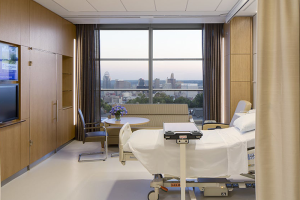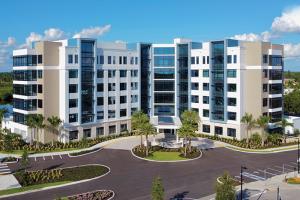Designing for behavioral and mental health care patients
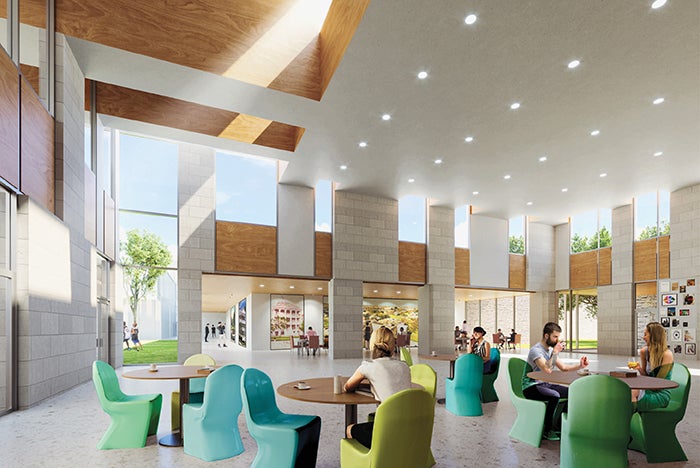
The Town Center at Austin (Texas) State Hospital provides a central gathering space for patients, visitors and staff.
Rendering courtesy of Page and architecture by Page/architecture+, associated architects
The variety of settings previously used and sometimes still used for the care of persons who are experiencing behavioral and mental illness not only catalog the history of attitudes toward behavioral and mental care, but they also provide initial evidence of the field’s intention to create a future that provides an appropriately rich diversity of care settings anchored by the needs of treatment and recovery as motivating care model drivers.
While the main behavioral and mental care setting has historically been anchored in large, long-stay public hospital settings, the current array of care settings emphasize a continuum of care encompassing traditional medium- and long-term stay hospitals, short-stay units at general hospitals, a variety of community-based residential care settings, transitional living and supportive housing, and an assortment of outpatient treatment settings, such as intensive outpatient, psychiatric partial hospitalization and a recent profusion of psychiatric/crisis/emergency care settings.
Advancing care models
Thanks to psychologist Carl Rogers, the concept of patient-centered care began to emerge in the mid-20th century and gained formal recognition as a health care principle in the late 20th and early 21st centuries. This and other drivers motivated hospitals to revisit what types of treatment were effective and where they might be provided, and identify the implications on space needs and hospital design. This movement led to a series of recommendations that impacted hospital design and planning:
- Creating dedicated active treatment zones and tracking their usage could make it easier for hospitals to demonstrate that standards of active treatment were being met and that patient safety and outcomes improved.
- The use of such zones, commonly referred to as treatment malls, have shown to be clinically effective while offering the possibility of a broader array of person-centered treatment options than was possible with on-unit treatment alone.
While treatment malls are frequently centrally located on a campus, access to these spaces was difficult for the most fragile patients, and the use of centralized malls required a significant investment in staff for patient escort and duplicate supervision at the mall itself, and for patients left behind on units.
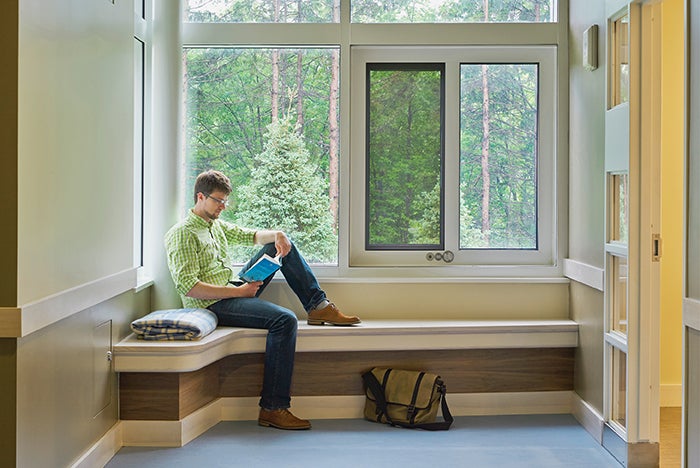
A window seat provides an opportunity for patient agency at Vermont Psychiatric Care Hospital in Berlin.
Image by Jim Westphalen and architecture by architecture+ and Black River Design, associated architects
The location of treatment malls directly adjacent to inpatient units has a positive impact on patient treatment participation rates at a lower staffing cost, according to anecdotal evidence. The logic behind these statements is fairly straightforward, as the neighborhood malls are under the span of control of direct care staff without the need to transport patients longer distances. Moreover, the direct proximity also facilitates movement of the most fragile patients, avoiding the need to split nursing staff between two locations during active treatment time.
The move from custodial care toward active treatment occurred at the same time that clinicians independently began to advocate for the benefits of person-focused care in psychosocial rehabilitation (PSR) and recovery-based care models. These newer care models form the basis for most current thinking about appropriate clinical care for persons whose behavioral and mental illness is serious enough to warrant hospitalization.
PSR is a comprehensive approach to recovery for individuals with psychiatric disabilities that focuses on helping them develop skills and access resources to increase their capacity to be successful in their living, working, learning and social environments. It differs from traditional medical and psychotherapeutic approaches in its emphasis on functional improvement in real-world contexts rather than solely focusing on symptom reduction. It recognizes that recovery involves not only managing symptoms but also rebuilding a meaningful life in the community.
The distinction between PSR and recovery-based care is subtle but important, as they represent an evolution in thinking rather than completely separate approaches. Recovery-based care emerged later (1990s to 2000s) as a broader philosophy and orientation that is more person-centered, emphasizing the individual’s own definition of recovery. Accordingly, it focuses on hope, identity, meaning and empowerment beyond functional improvements. It emphasizes subjective aspects of recovery, including personal growth, self-determination and finding purpose.
In practice, effective contemporary behavioral and mental health systems integrate both approaches, using PSR techniques within a recovery-oriented framework that respects individual choice, promotes hope and addresses all aspects of a person’s life beyond simply managing symptoms or building skills.
Facilities designed to provide care within PSR and recovery-based care models are frequently characterized by the following features (the longer the length of stay, the more so):
- Treatment malls located separately from inpatient units are used intensively during scheduled morning and afternoon treatment hours, providing services to either the entirety of a hospital’s population or in a neighborhood treatment mall setting directly adjacent to inpatient units.
- Treatment settings that range from purpose-built rooms, such as gymnasiums and libraries, to spaces supporting equipment-based or functionally challenging activities, such as music therapy, dance/movement, and arts and crafts.
- Generalizable and flexible treatment settings that can be adapted for use in support of individual patients’ treatment and life goals. The proliferation of flexible multi-purpose consultation, group therapy and group activity rooms is a significant feature of PSR and recovery-based treatment environments.
- An arrangement of diverse clinical and social settings allowing patients and clinicians to test and observe emerging capacities, skills and functional needs with a richness that cannot be achieved solely in unit-based treatment programs.
Design responses
In 1998, The Joint Commission issued a Sentinel Event Alert calling the field’s attention to the increased prevalence of self-harm attempts using ligatures with attachment points at and below waist height, far lower than existing design standards considered.
This notice almost immediately led to a reconsideration of the design of fixtures and fittings below waist height within the hospital environment. For the first time, everyday fixtures like lavatory handles, plumbing fixtures, grab bars and doorknobs were seen as dangerous, and in the then-absence of devices purposefully designed for the behavioral and mental health market, devices designed for the correctional market were pressed into service.
Recognizing that stigma and trauma are impediments to effective treatment, designers, facilities managers, clinicians and manufacturers began to develop and advocate for the utilization of patient-safe, non-correctional fixtures and fittings.
The ensuing years have seen a dramatic increase in more appropriate and safe devices for hospital settings and the flourishing of an industry dedicated to the design, production and installation of patient-safe and normative products.
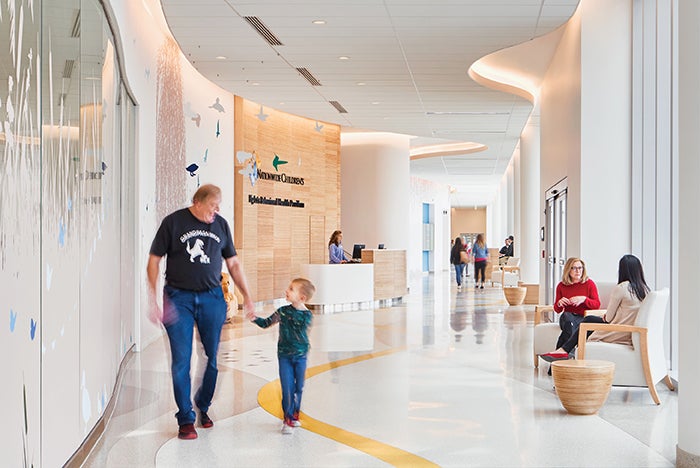
The main lobby of Big Lots Pavilion at Nationwide Children’s Hospital in Columbus, Ohio, provides a stigma-free environment.
Image by Edward Caruso Photography and architecture by NBBJ and architecture+, associated architects
However, even as behavioral and mental health care models were evolving and defining themselves in ways that could begin to influence architectural response, developments in related fields of environmental psychology and general hospital design and operations also were beginning to suggest an important nexus between environmental design, human experience and health outcomes.
The relationship between person and place has a long history of informal inquiry. That inquiry became recognized as a discipline through the interaction of psychiatrists, sociologists, anthropologists and psychologists, who were contemporaneously working on the subject and communicating with each other in the late 1950s and 1960s. This interdisciplinary work was formalized as a discipline with the establishment of the environmental psychology program at The City University of New York, a step that was preceded by Roger Sommer’s teaching of environmental psychology as a course in 1964 at Cornell University.
The establishment of the Environmental Design Research Association in 1968 enlarged participation in the environmental psychology academic community to include designers with an interest in the field; an expansion of interdisciplinary research and collaborations in the 1980s and 1990s that, through institutions like Planetree and The Center for Health Design as well as health care design events, led to significant changes in the design of hospitals in the United States; and an evolution that has had its own salutary impact on the design of the modern psychiatric hospital.
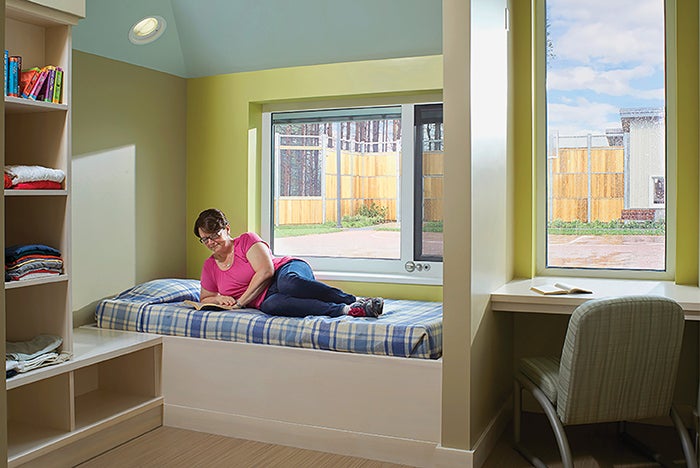
The bedrooms at Vermont Psychiatric Care Hospital provide many experiential opportunities.
Image by Jim Westphalen and architecture by architecture+ and Black River Design, associated architects
The psychiatric hospital was an early subject of study for this new discipline, and the intersections and interactions between the psychiatric hospital as a field of study and the early pioneers of environmental psychology provided a rich mix of collaborations that continue to influence their design 60 to 70 years later.
Space, time, human interaction and personal agency are all at work within the dynamics of environmental psychology. Architecture has come to understand that the creation of form is simultaneously a creation that influences human experience and the creation of new opportunities for personal and interpersonal experience, which are key components of effective recovery-based care.
For example, pilot demonstration programs at psychiatric hospitals in the U.S. and the United Kingdom are exploring the use of autonomous monitoring through assorted electromagnetic radiation frequencies (e.g., infrared, lidar and ultra-wideband surveillance radar) to monitor patient presence, movement and vital signs using Food and Drug Administration 510(k) Class II-cleared technologies, which promise to fundamentally change staff workflows and afford a better capacity to monitor patient status, including avoiding sentinel events, without the necessity of performing 15-minute bed checks, thereby permitting patients better sleep and staff greater focus on relational work as the supervisory work decreases.
This same technology, artfully incorporated, could provide some beneficial opportunities to support the agency that patients need to develop the insights that support recovery.
Finding the balance
Providing safe, secure and trauma-informed care settings are admirable and necessary objectives that embody medicine’s own ethos: “First, do no harm.” However, it merely creates a basis for an effective care environment. The effective clinical relationship requires designers to support the journey to recovery. In support of the essential combination of insight and discernment upon which PSR and recovery-based care rely, facilities designers need to not only remove impediments but also create supports.
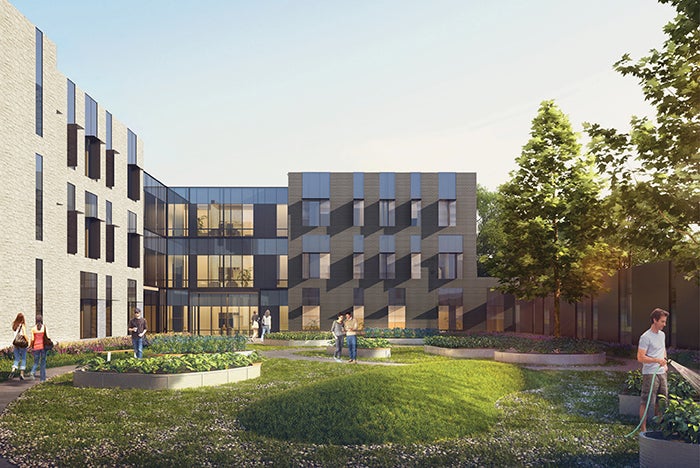
Every inpatient unit has access to the outdoor courtyard at Austin State Hospital.
Rendering by Page and architecture by Page/architecture+, associated architects
Currently, attention is clearly called to removing the risks attendant to unsafe and unsecured environments that are easy to see and come with significant penalties. However, designers also should continue to provide attention to the other essential questions that arise from PSR and recovery-based care.
Ultimately, they should ask themselves: What can a designer do to help caregivers develop the discernment that is needed to develop a person-based recovery plan with a patient, and what can designers do to assist persons experiencing a behavioral or mental illness to develop the insight, hope and resilience that can empower their own journey of recovery?
Related article // Six important design trends in therapeutic care facilities design
Six important trends have driven and continue to drive significant change in behavioral and mental hospital settings. The best hospital settings will accommodate each of these drivers without letting the response to any one driver come at the expense of satisfying any other:
- Federal and state civil rights laws with respect to custodial care and active treatment in the least restrictive settings.
- The emergence of psychosocial rehabilitation and recovery-based care models as examples of effective care for persons experiencing behavioral and mental illness.
- Federal and The Joint Commission policies about patient safety (and accompanying considerations about security) being an imperative driver for facility design and operation.
- An expanding evidence base arising from research — particularly in environmental psychology — is providing significant lessons about the types of settings that either support or inhibit care, including trauma-informed care settings and care models.
- A growing recognition that behavioral and mental health care, like other forms of health care, is best provided based on early diagnosis and treatment and in a context that is patient-centered and focused on the development of skills and attitudes centered on a patient’s life goals by capitalizing on their capacities, hope and resilience.
- Artificial intelligence (AI), coupled with anonymizing sensing technologies, is creating the possibility for greater knowledge and understanding in advance of an adverse event and promises to fundamentally change supervisory workflows. Of course, the use of AI should include guardrails — policies, rules and mechanisms designed to ensure AI systems behave ethically, legally and responsibly, preventing harmful, biased or unauthorized behavior.
The effective designer needs to understand these trends and their implications for facilities planning and design. Achieving this balance among sometimes seemingly contending interests is critical and difficult. However, the effort is necessary and beneficial.
About this article
This feature is one of a series of articles published by Health Facilities Management in collaboration with the American College of Healthcare Architects.
Francis Murdock Pitts, FAIA, FACHA, OAA, is principal at architecture+ in Troy, N.Y. He can be reached at pittsf@aplususa.com.


